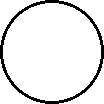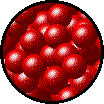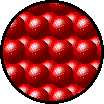

Gases, liquids and solids are all made up of atoms, molecules, and/or ions, but the behaviors of these particles differ in the three phases. The following figure illustrates the microscopic differences.
 |
 |
 |
| Microscopic view of a gas. | Microscopic view of a liquid. | Microscopic view of a solid. |
Note that:
The following table summarizes properties of gases, liquids, and solids and identifies the microscopic behavior responsible for each property.
| Some Characteristics of Gases, Liquids and Solids and the Microscopic Explanation for the Behavior | ||
|---|---|---|
| gas | liquid | solid |
| assumes the shape and volume of its container
particles can move past one another |
assumes the shape of the part of the container which it
occupies
particles can move/slide past one another |
retains a fixed volume and shape
rigid - particles locked into place |
| compressible
lots of free space between particles |
not easily compressible
little free space between particles |
not easily compressible
little free space between particles |
| flows easily
particles can move past one another |
flows easily
particles can move/slide past one another |
does not flow easily
rigid - particles cannot move/slide past one another |
